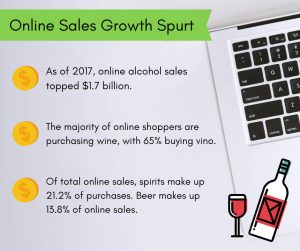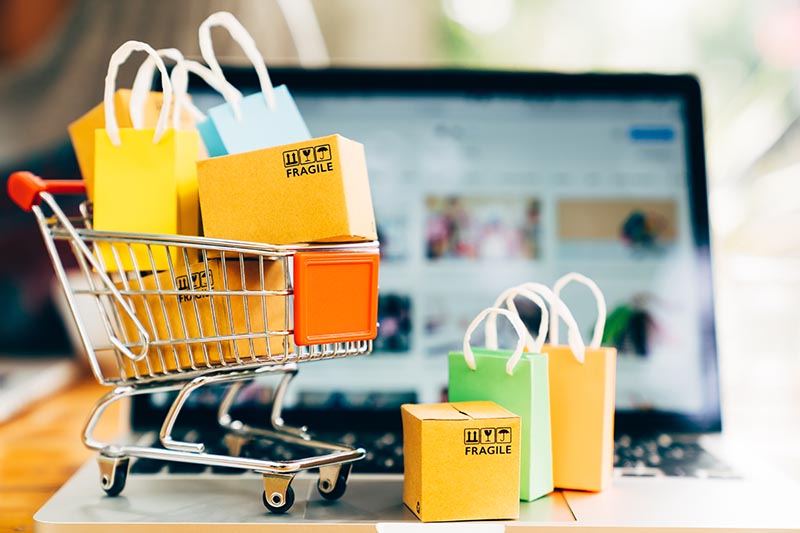The experience of buying wine and spirits is no longer limited to the liquor store. Consumers can buy almost anything online, but for years the alcohol industry was slow to transition sales online because of strict state laws.
As the laws are relaxing and online is more dominant than ever, the transition to selling online has happened and is growing rapidly. Let’s examine this trend and how alcohol suppliers can take advantage of it.
Drinks, on demand
Online alcohol sales topped $1.7 billion in 2017, according to a report by Rabobank.
The report stated that e-Commerce sales “dwarfed” that of traditional brick and mortar. On-demand alcohol delivery apps are adding to this, totaling $100 million in sales, up from $0 in 2013.
Now, customers can order a drink without ever leaving their couch — and get that drink fast.
On-demand delivery apps, such as the giant Drizly, allow customers to order wine or spirits via an app and get them delivered to their front door. You select what you’d like from a nearby liquor store and it’s then delivered to you in less than one hour.
“Estimates are that alcohol ecommerce in the US will continue to grow in the 30% to 40% range year on year for the next five years, which would scale the market to about $6 billion to $9 billion by 2023,” Justin Robinson, senior vicepresident of new business at Drizly told The Spirit Business.

Drizly’s revenue grew by 61.8% from 2016 to 2017. Wine.com is the only other online realtor that came close to matching Drizly’s market share.
Other online giants are also noticing that the way alcohol is purchased is changing. Amazon Prime, now via Whole Foods, and UberEats have also taken to online delivery of drinks.
Wine clubs and DTC
Even boutique and small-family wineries are capitalizing on the revenue stream from online sales.
While wineries formally only sold from their tasting rooms, online sales have opened up a way for them to serve repeat customers and expand sales. Former visitors can go online or join the vineyard’s wine club to keep drinking the product. Direct-to-consumer winery sales are up 15.5% for wineries from 2016.
Other companies are creating online-only wine clubs. Winc and Naked Wines promote independent wineries and run their clubs completely online.
A new consumer, online
The type of shopper who buys alcohol online is different than the average grocery store or liquor store shopper.
The majority of online shoppers are purchasing wine, with 65% buying vino. Of total online sales, spirits make up 21.2% of purchases. Beer makes up 13.8% of online sales.
Online beer buyers are more often male and are younger, but have a higher income and buy beer as part of their routine shopping.
The same analysis found that an omnichannel customer spent more consistently and was more loyal than an in-store only customer, according to IDC FutureScape, Kantar Retail Analysis.
What your company can do to increase online sales
If you’re looking to increase online sales for your winery or distillery, here are some tips:
- Start with upgrading your website. A modern but easily accessible design will help customers navigate how to purchase your wines online.
- You’ll also want to ensure you have the right backend to your website to track and organize your sales. If you have issues fulfilling customer orders, it can set back your online business.
- Advertise your website in your tasting room and in liquor stores, so customers know exactly where to find you.
- Reach out to brands such as Drizly and beef up your online “shelf.” Ensuring your descriptions are correct will help boost sales. Then, Drizly even offers a way for you to track where your brands are sold to help you make the best decisions for your products.
Brands have endless, untapped opportunities to engage with customers online, so creating a strategy is a great first step. If you want your brand to grow into the 2020s, capitalizing on online sales will help you get there.
- 87% of Utilities Have Experienced at Least One Data Breach in Last Three Years - February 5, 2024
- Can Drones Lower Your Next Utility Bill? - January 10, 2024
- Onshore Wind Farms Are The Next Big Thing In Renewable Energy - December 6, 2023




